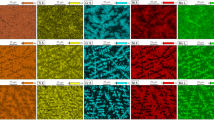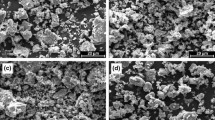Abstract
The electrochemical behavior of TiNi(1−x)Nbx (x = 0, 0.05, 0.1, 0.2) ternary intermetallic compounds synthesized by mechanical alloying was investigated and compared to that of binary TiNi. The structure of 20-h milled product with initial stoichiometric composition of TiNi0.95Nb0.05 was found to be amorphous/nanostructured. Upon cycling, this ternary milled product exhibited the highest discharge capacity (166.1 mA h/g) after 10 cycles and best cycle stability (∼91%) while those of the binary TiNi were 147 mA h/g and ∼83%, respectively; i.e., slight amount of Nb substitution (0.05 mol) for Ni in the TiNi not only increased discharge capacity and cycle stability but also enhanced the kinetics of hydrogen absorption/desorption through increasing the exchange current density and hydrogen diffusion coefficient. However, additional Nb content was found to have negative effect on electrochemical properties; this was related to the existence of Nb element in addition to the ternary amorphous/nanocrystalline structures.








Similar content being viewed by others
References
M. Tliha, C. Khaldi, S. Boussami, N. Fenineche, O. El-Kedim, H. Mathlouthi, and J. Lamloumi: Kinetic and thermodynamic studies of hydrogen storage alloys as negative electrode materials for Ni/MH batteries: A review. J. Solid State Electrochem. 18, 577 (2014).
B. Guiose, F. Cuevas, B. Decamps, and A. Percheronguegan: Solid–gas and electrochemical hydrogenation properties of pseudo-binary (Ti,Zr)Ni intermetallic compounds. Int. J. Hydrogen Energy 33, 5795 (2008).
H. Emami and F. Cuevas: Hydrogenation properties of shape memory Ti(Ni,Pd) compounds. Intermetallics 19, 876 (2011).
H. Emami, F. Cuevas, and M. Latroche: Ti(Ni,Cu) pseudobinary compounds as efficient negative electrodes for Ni–MH batteries. J. Power Sources 265, 182 (2014).
Z. Zhang, O. Elkedim, Y.Z. Ma, M. Balcerzak, and M. Jurczyk: The phase transformation and electrochemical properties of TiNi alloys with Cu substitution: Experiments and first-principle calculations. Int. J. Hydrogen Energy 42, 1444 (2017).
H. Emami and F. Cuevas: Cobalt induced multi-plateau behavior in TiNi-based Ni–MH electrodes. Energy Storage Mater. 8, 189 (2016).
B. Guiose, F. Cuevas, B. Décamps, E. Leroy, and A. Percheron-Guégan: Microstructural analysis of the ageing of pseudo-binary (Ti,Zr)Ni intermetallic compounds as negative electrodes of Ni–MH batteries. Electrochim. Acta 54, 2781 (2009).
M. Makowiecka, E. Jankowska, I. Okonska, and M. Jurczyk: Effect of Zr additions on the electrode characteristics of nanocrystalline TiNi-type hydrogen storage alloys. J. Alloys Compd. 388, 303 (2005).
B. Drenchev, T. Spassov, and D. Radev: Influence of alloying and microstructure on the electrochemical hydriding of TiNi-based ternary alloys. J. Appl. Electrochem. 38, 437 (2007).
A. Szajek, M. Makowiecka, E. Jankowska, and M. Jurczyk: Electrochemical and electronic properties of nanocrystalline TiNi1−xMx (M = Mg, Mn, Zr; x = 0, 0.125, 0.25) ternary alloys. J. Alloys Compd. 403, 323 (2005).
B. Drenchev and T. Spassov: Influence of B substitution for Ti and Ni on the electrochemical hydriding of TiNi. J. Alloys Compd. 474, 527 (2009).
F. Cuevas, M. Latroche, and P. Ochin: Influence of polymorphism on the electrochemical properties of (Ti0.64Zr0.36) Ni alloys. J. Alloys Compd. 357, 730 (2003).
M. Balcerzak: Electrochemical and structural studies on Ti–Zr–Ni and Ti–Zr–Ni–Pd alloys and composites. J. Alloys Compd. 658, 576 (2016).
M. Balcerzak, M. Nowak, J. Jakubowicz, and M. Jurczyk: Electrochemical behavior of nanocrystalline TiNi doped by MWCNTs and Pd. Renewable Energy 62, 432 (2014).
X.D. Li, O. Elkedim, M. Nowak, and M. Jurczyk: Characterization and first principle study of ball milled Ti–Ni with Mg doping as hydrogen storage alloy. Int. J. Hydrogen Energy 39, 9735 (2014).
Z. Zlatanova, T. Spassov, G. Eggeler, and M. Spassova: Synthesis and hydriding/dehydriding properties of Mg2Ni–AB (AB = TiNi or TiFe) nanocomposites. Int. J. Hydrogen Energy 36, 7559 (2011).
N.A.A. Rusman and M. Dahari: A review on the current progress of metal hydrides material for solid-state hydrogen storage applications. Int. J. Hydrogen Energy 41, 12108 (2016).
M. Jurczyk, L. Smardz, and A. Szajek: Nanocrystalline materials for Ni–MH batteries. Mater. Sci. Eng., B 108, 67 (2004).
S.F. Kashani-Bozorg, M. Mohri, and A. Ebrahimi-Purkani: Electrode properties of nanostructured and amorphous Mg1.75Nb0.25Ni compound produced by mechanical alloying. Adv. Mater. Res. 55–57, 581 (2008).
M. Mohri and S.F. Kashani-Bozorg: An electrochemical investigation of nanocrystalline Mg2Nb0.25Ni0.75 compound synthesized by mechanical alloying. Int. J. Mod. Phys. B 22, 2939 (2008).
C.S.S. Wang, Y.Q.Q. Lei, and Q.D.D. Wang: Effects of Nb and Pd on the electrochemical properties of a Ti–Ni hydrogen-storage electrode. J. Power Sources 70, 222 (1998).
G. Hapçı Ağaoğlu and G. Orhan: Elaboration and electrochemical characterization of Mg–Ni hydrogen storage alloy electrodes for Ni/MH batteries. Int. J. Hydrogen Energy 42, 8098 (2017).
C. Suryanarayana: Mechanical alloying and milling. Prog. Mater. Sci. 46, 1 (2001).
S. Rousselot, D. Guay, and L. Roué: Comparative study on the structure and electrochemical hydriding properties of MgTi, Mg0.5Ni0.5Ti, and MgTi0.5Ni0.5 alloys prepared by high energy ball milling. J. Power Sources 196, 1561 (2011).
X.D. Li, O. Elkedim, M. Nowak, M. Jurczyk, and R. Chassagnon: Structural characterization and electrochemical hydrogen storage properties of Ti2−xZrxNi (x = 0, 0.1, 0.2) alloys prepared by mechanical alloying. Int. J. Hydrogen Energy 38, 12126 (2013).
S.M. Lee, H. Lee, J.S. Yu, G.A. Fateev, and J.Y. Lee: Activation characteristics of a Zr-based hydrogen storage alloy electrode surface-modified by ball-milling process. J. Alloys Compd. 292, 258 (1999).
B. Abrashev, T. Spassov, S. Bliznakov, and A. Popov: Microstructure and electrochemical hydriding/dehydriding properties of ball-milled TiFe-based alloys. Int. J. Hydrogen Energy 35, 6332 (2010).
M. Gao, S. Zhang, H. Miao, Y. Liu, and H. Pan: Pulverization mechanism of the multiphase Ti–V-based hydrogen storage electrode alloy during charge/discharge cycling. J. Alloys Compd. 489, 552 (2010).
X. Zhao and L. Ma: Recent progress in hydrogen storage alloys for nickel/metal hydride secondary batteries. Int. J. Hydrogen Energy 34, 4788 (2009).
X. Zhao, L. Ma, M. Yang, Y. Ding, and X. Shen: Electrochemical properties of Ti–Ni–H powders prepared by milling titanium hydride and nickel. Int. J. Hydrogen Energy 35, 3076 (2010).
A. Etiemble, S. Rousselot, W. Guo, H. Idrissi, and L. Roué: Influence of Pd addition on the electrochemical performance of Mg–Ni–Ti–Al-based metal hydride for Ni–MH batteries. Int. J. Hydrogen Energy 38, 7169 (2013).
C. Jiang, H. Wang, Y. Wang, X. Chen, Y. Tang, Z. Liu, and H. Xie: Enhanced electrochemical performance of Mg2Ni alloy prepared by rapid quenching in magnetic field. J. Power Sources 238, 257 (2013).
M. Ma, D. Wang, X. Hu, X. Jin, and G.Z. Chen: A direct electrochemical route from ilmenite to hydrogen-storage ferrotitanium alloys. Chem.–Eur. J. 12, 5075 (2006).
ACKNOWLEDGMENTS
Partial financial support by Center of Excellence for Surface Engineering and Corrosion Protection of Industries, University of Tehran, and Iran Nanotechnology Initiative Council are gratefully acknowledged.
Author information
Authors and Affiliations
Corresponding author
Rights and permissions
About this article
Cite this article
Abbasi, R., Kashani-Bozorg, S.F. Electrochemical and kinetic performance of amorphous/nanostructured TiNi-based intermetallic compound with Nb substitution synthesized by mechanical alloying. Journal of Materials Research 33, 3774–3784 (2018). https://doi.org/10.1557/jmr.2018.231
Received:
Accepted:
Published:
Issue Date:
DOI: https://doi.org/10.1557/jmr.2018.231




